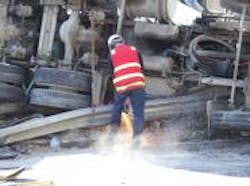Truck research that is worth the price tag
So it was with a bit of surprise that I opened my email that recent morning to find a press release issued jointly from the Owner-Operators Independent Drivers Assn. (OOIDA) and American Trucking Assns. (ATA) regarding tractor/truck cab safety. The release included a letter the organizations have written to David L. Strickland, administrator of the National Highway Traffic Safety Administration (NHTSA).
Why did this release surprise me so?
It turns out that there are no federal safety guidelines for crashworthiness for vehicles 26,001 lbs. or heavier. With all the focus the government has on safety, particularly in regards to large truck safety, why would there be no national standard for tractor/truck cab safety?
(You can read more about the issue here.)
The government has standards for cars and light trucks; in fact, we hear about them all the time - think about those television commercials we see touting “five-star” crash ratings – but according to the two associations, there are no uniform standards for Class 7 and 8 vehicles and they are requesting NHTSA undertake studies to work towards a standard.
“We are looking for a baseline that would enhance the survivability of drivers when crashes happen,” Todd Spencer, executive vice president of OOIDA told me. “We as an organization have raised this issue with federal officials many times.”
While each manufacturer has their own safety standards, there are no federal minimum standards. And Spencer was quick to point out that no one is suggesting that what manufacturers have been doing is putting anyone at risk, but that there needs to be a standard that every manufacturer must hit.
“Of the crashworthiness regulations issued by NHTSA, only those dealing with glazing materials, door locks and door retention components, seating systems, seat belts, child restraint systems, and rear impact guards apply to all commercial vehicles,” the letter stated. “Those addressing occupant protection, rear impact, head restraints, and roof crush resistance apply only to cars and light trucks.”
Among the points the letter makes is that 23% of truck driver fatalities could be prevented if the cab was structurally strengthened, and 63% of truck driver fatalities are a result of a rollover. According to the letter, in the “Large Truck and Bus Crash Facts for 2008, the Federal Motor Carrier Safety Administration (FMCSA) found that approximately 700 truck drivers have lost their lives each year for the last 10 years in either single or multi-vehicle large truck crashes.” Rollover crashes accounted for 63% of all fatalities.
The groups highlighted four areas where they would like to see further study: improved cab structure, particularly as it relates to rollovers; occupant restraint systems such as seat belts and airbags; improved windshield and door strength; and more forgiving interior surfaces that are capable of absorbing energy.
“If a seatbelt locks a driver into a cab, we don’t want that cab to become a coffin,” Spencer said. “We think there is more to learn [about safety].”
Both organizations are requesting research, but as Spencer told me, it can’t be research for research’s sake. The flip side to this, of course, is that improving safety can rarely be done without added cost. That would seem to be OK, especially in Spencer’s view, whose organization represents many independent or small fleet drivers who are hit particularly hard every time there is a price increase.
“Regardless of the cost,” he said, “we want survivors.”
It sounds as though this is a research study that is long overdue. Saving lives is a sentiment that I think everyone can, and should, rally around.
